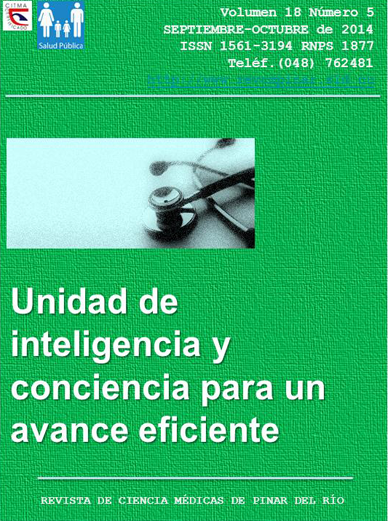Intestinal Schistosomiasis: a case report
Keywords:
Shistosomiasis, Parasitic intestinal diseases.Abstract
Introduction: intestinal schistosomiasis is a parasitic disease caused by helminths of the class trematode and genus Schistosoma, characterized by presenting in its acute stage diarrhea, dermatitis and abdominal pain, with high incidence in poor countries with insalubrity problems. The triggering factor of this parasitosis is associated to exposure to water contaminated by schistosomes eggs. It can be prevented with sanitation measures aimed at controlling sources of water supply. There is now high morbidity mainly in sub-Saharan Africa. The objective aimed at is explaining the epidemiology of this disease.Case report: the case of an adult female aged over 60 years is presented, with no history of the disease, which was on a medical collaboration in the province of Cunene in the sister Republic of Angola. She showed clinical symptoms during the months of January to March 2012, and it was confirmed by the laboratory as intestinal schistosomiasis. The specific and updated medication (praziquantel) was administered to the patient, with satisfactory results.
Conclusions: the literature describes treatment failures in which it has been required more than one cycle of praziquantel, which is not very common, but occurred in the case presented. The patient was assigned to take the medication together with food. No side effects were referred as presented.
Downloads
References
1. Organización mundial de la salud. Esquistosomiasis Nota descriptiva No. 115[Internet]. Centro de Prensa; 2012 . Disponible en: http://www.who.int/mediacentre/factsheets/fs115/es/ [Consultado jun 2013]
2. National Travel Health Network and Center. Schistomiasis [Internet]. Health Protection Agency; 2008 [Consultado abr 2012]; Disponible en: http://www.nathnac.org/pro/factsheets/pdfs/schistosomiasis.pdf
3. González R. Evaluación sistemática de costos ambientales para el desarrollo de proyectos sustentables con financiamiento de bonos de carbono. En: Avances en impacto, tecnología y toxicología ambiental. Hidalgo, México: 2011: 51-73
4. República Dominicana. Ministerio de Salud Pública. Dirección General de Epidemiología. Bilharzia/Esquistosomiasis[Internet]. Santo Domingo: Ministerio de Salud Pública; 2012. Disponible en: http://www.digepisalud.gob.do/vigilancia-epidemiologica/protocolos/bilharziaesquistosomiasis-cie-b65.html [Consultado abr 2012]
5. Rojas Rodríguez de Quesada M, Azcoaga Lorenzo A, Vidal Serrano S. Equistosomiasis humana: manifestaciones clínicas, diagnóstico y tratamiento. JANO [Internet] 2009 [Consultado abr 2012]; (1746): 14. Disponible en: http://www.jano.es/ficheros/sumarios/1/0/1746/14/00140018_LR.pdf
6. Gray DJ, Allen G, Yue-Sheng, McManus DP. Esquistosomiasis: diagnóstico y manejo clínico. BMJ [Internet] 2011 [Consultado abr 2012];; 342: 2651-2651. Disponible en: http://www.intramed.net/contenidover.asp?contenidoID=71317
7. Cuba. Ministerio de Salud Pública. Enfermedades tropicales: Esquistosomiasis, Leishmaniosis y Tripanosomiasis: revisión bibliográfica. Santiago de Cuba: Facultad de Ciencias Médicas II; 2010.
8. Heyman DL. Control of Communicable Diases Manual. En: Shistosomiasis 19 ed. Washington: Americam public Health. Association Pres; 2008: 544-47.
9. Cuba. Ministerio de Salud Pública. Resolución no.4. Bioética. La Habana: MINSAP; 2000.
Published
How to Cite
Issue
Section
License
Authors who have publications with this journal agree to the following terms: Authors will retain their copyrights and grant the journal the right of first publication of their work, which will be publication of their work, which will be simultaneously subject to the Creative Commons Attribution License (CC-BY-NC 4.0) that allows third parties to share the work as long as its author and first publication in this journal are indicated.
Authors may adopt other non-exclusive license agreements for distribution of the published version of the work (e.g.: deposit it in an institutional telematic archive or publish it in a volume). Likewise, and according to the recommendations of the Medical Sciences Editorial (ECIMED), authors must declare in each article their contribution according to the CRediT taxonomy (contributor roles). This taxonomy includes 14 roles, which can be used to represent the tasks typically performed by contributors in scientific academic production. It should be consulted in monograph) whenever initial publication in this journal is indicated. Authors are allowed and encouraged to disseminate their work through the Internet (e.g., in institutional telematic archives or on their web page) before and during the submission process, which may produce interesting exchanges and increase citations of the published work. (See The effect of open access). https://casrai.org/credit/



